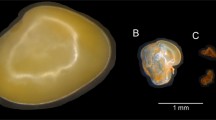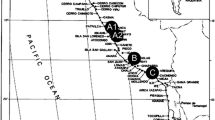Summary
F1 progeny from three classes of crosses were studied for indications of incongruity in the form of reproductive dysfunction. Percent fruit set was found to be approximately equivalent to the additive inverse of percent aborted flowers, as the effect of shot berries was small and not significant. In interspecific crosses, barriers were manifested as reduced fruit set and seed number per berry. These two characters were used to create an index of reproductive efficiency. Nine F1s from crosses of most divergent class, V. riparia × V. vinifera (R × V), displayed significantly tower reproductive efficiency, percent fruit set, and seed number per berry. Four female F1s from the least divergent class, V. riparia × V. riparia (R × R), had the highest reproductive efficiency, percent fruit set and seed number per berry, when pollinated by two V. riparia pollen sources. Seventeen F1s from the highly-intercrossed class, V. riparia × French Hybrid (R × FH), displayed intermediate levels of reproductive efficiency, percent fruit set, and seed number per berry. The R × FH class involved V. vinifera, V. rupestris, V. aestivalis, V. labrusca, V. berlandieri, V. cinerea, and V. riparia. It is proposed that the complex intercrossing in the pedigrees of the R × FH class ameliorated incongruity. In the most divergent class, R × V, progenies of one of the V. riparia parents displayed fewer incongruity effects than progenies of the other V. riparia parents. Progeny testing of many proposed parental combinations may be used to uncover useful congruent combinations.
Similar content being viewed by others
References
Barrett H.C., 1958a. The best parents in breeding French Hybrid grapes. Fruit Var. Hort. Dig. 12: 39–42.
Barrett H.C., 1958b. The best parents in breeding French Hybrid grapes (Part II). Fruit Var. Hort. Dig. 12: 55–59.
Einset J. & C.Pratt, 1975. Grapes. In: J.N.Moore & J.Janick (Eds). Advances in Fruit Breeding, pp. 130–153. Purdue Univ. Press, Lafayette, Ind.
Galet P., 1979. A Practical Ampelography. Comstock Publishing Associates, division of Cornell University Press, Ithaca and London.
Galet P., 1988. Cépages et vignobles de France, Tome 1, Les vignes Américaines. 2nd edition. Charles Déhan, Montpellier.
Gonzalez L.G. & B.-V.Ford-Lloyd, 1987. Facilitation of wide-crossing through embryo rescue and pollen storage in interspecific hybridization of cultivated Allium species. Plant Breeding 98: 318–322.
Haghighi K.R. & P.-D.Ascher, 1988. Fertile, intermediate hybrids between Phaseolus vulgaris and P. acutifolius from congruity backcrossing. Sex. Plant Reprod. 1: 51–58.
Hogenboom N.G., 1973. A model for incongruity in intimate partner relationships. Euphytica 22: 219–233.
Hogenboom N.G., 1975. Incompatibility and incongruity: two different mechanisms for the non-functioning of intimate partner relationships. Proc. R. Soc. Lond. B. 188: 361–375.
Hogenboom, N.G., 1984. Incongruity: non-functioning of intercellular and intracellular partner relationships through non-matching information. Encycl-Plant-Physiol-New-Ser.: Cellular Interactions. Berlin, W. Ger. pp. 640–654.
Levin D., 1971. The origin of reproductive isolating mechanisms in flowering plants. Taxon 20: 91–113.
Luby J.J., 1991. Breeding cold-hardy fruit crops in Minnesota. HortScience 26: 507–512.
Manshardt R.M. & T.-F.Wenslaff, 1989a. Zygotic polyembryony in interspecific hybrids of Carica papaya and C. cauliflord. J. Amer. Soc. Hort. Sci. 114: 684–689.
Manshardt R.M. & T.-F.Wenslaff, 1989b. Interspecific hybridization of papaya with other Carica species. J. Amer. Soc. Hort. Sci. 114: 689–694.
McNaughton I.H. & J.-L.Harper, 1960. Comparative biology of closely related species living in the same area: II. Aberrant morphology and a virus-like syndrome in hybrids between Papaver rhoeas and P. dubium. New Phytologist 59: 27–41.
Ojala A. & A.Rousi, 1986. Interspecific hybridization in Papaver. 1. F1 hybrids of Papaver somniferum with perennial species of sect. Oxytona. Ann-Bot-Fenn. Helsinki: The Finnish Botanic Publishing Board. 23 (4): 289–303.
Olmo H.P., 1942. Choice of parent as influencing seed germination in fruits. Proc. Amer. Soc. Hort. Sci. 41: 171–175.
Pal M. & T.-N.Khoshoo, 1972. Evolution and improvement of cultivated amaranths. V. Inviability, weakness and sterility in hybrids. J. Heredity 63: 78–82.
Rhodes A.M., 1959. Species hybridization and interspecific gene transfer in the genus Cucurbita. Proc. Amer. Soc. Hort. Sci. 74: 546–551.
Stebbins G.L., 1958. The inviability, weakness, and sterility of interspecific hybrids. Adv. in Genet. 9: 147–215.
Stebbins G.L., 1971. Processes of organic evolution. Prentice-Hall, Inc., Englewood Cliffs, New Jersey.
Stephens S.G., 1946. The genetics of ‘corky’. I. The new world alleles and their possible role as an interspecific isolating mechanism. J. Genet. 47 (2): 150–161.
Swenson E.P., 1985. Wild Vitis riparia from northern U.S. and Canada—breeding source for winter hardiness in cultivated grapes — A background of the Swenson hybrids. Fruit Var. J. 39: 28–31.
Vickery R.Jr., 1964. Barriers to gene exchange between members of the Mimulus guttatus complex (Scrophulariaceae). Evolution 18: 52–69.
Viehmeyer G., 1958. Reversal of evolution in the genus Penstemon. The Amer. Naturalist 42: 129–137.
Whitaker T. & W.-P.Bemis, 1964. Virus-like syndromes of Cucurbita species hybrids. Heredity 19: 229–236.
yabuya T., 1991. Chromosome associations and crossability with Iris ensata Thumb. in induced amphidiploids of I. laevigata Fisch. x I. ensata. Euphytica 55: 85–90.
Author information
Authors and Affiliations
Additional information
Minnesota Agricultural Experiment Station, Scientific Journal Series No. 20835
Rights and permissions
About this article
Cite this article
Filler, D.M., Luby, J.J. & Ascher, P.D. Incongruity in the interspecific crosses of Vitis L. Reproductive expression in the F1 progeny. Euphytica 78, 155–164 (1994). https://doi.org/10.1007/BF00021412
Received:
Accepted:
Issue Date:
DOI: https://doi.org/10.1007/BF00021412




